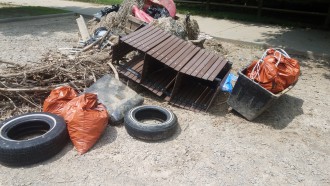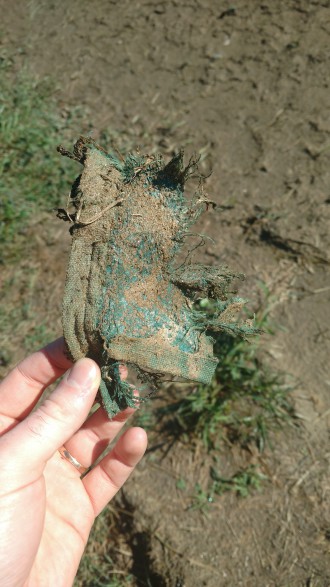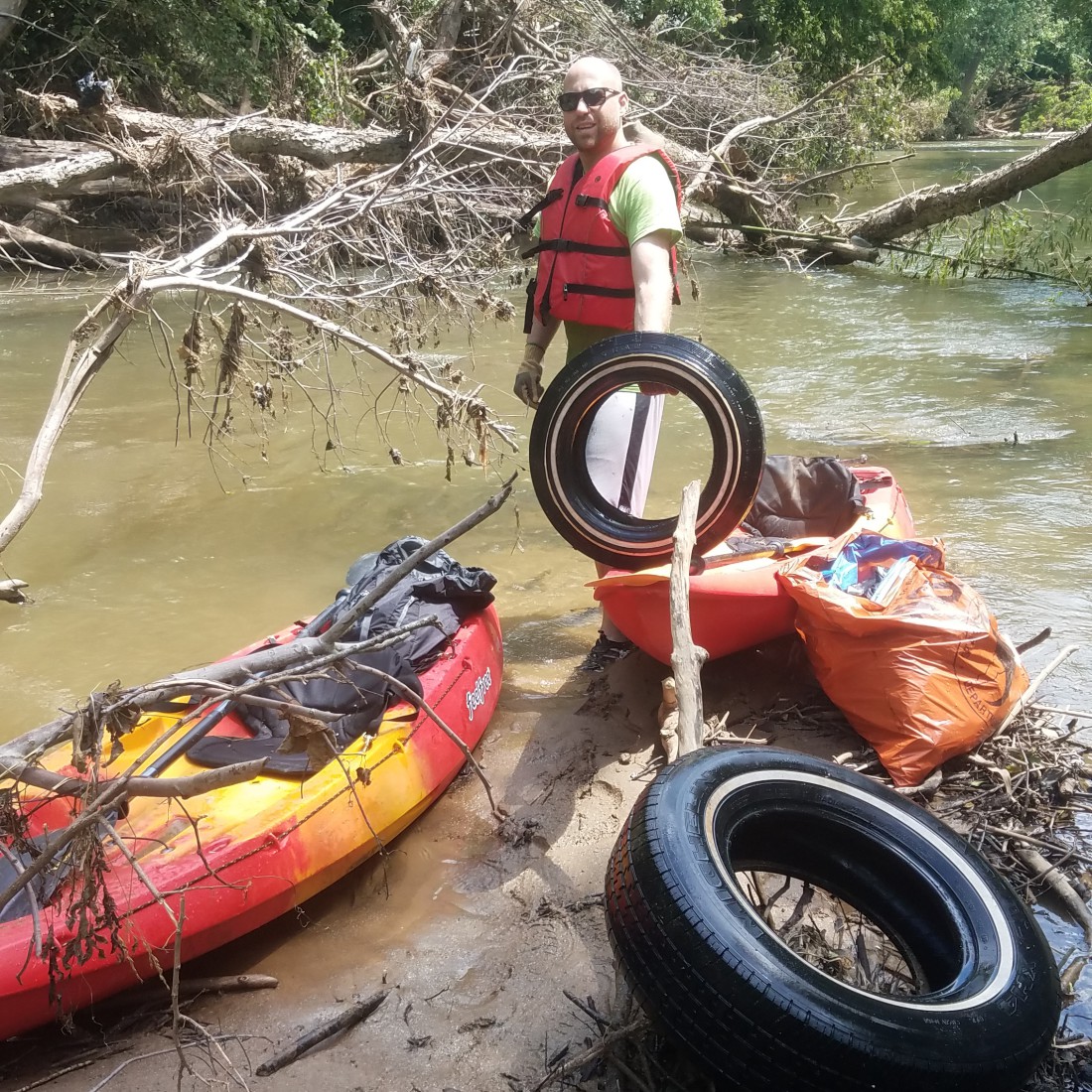“It was pure wreckage,” says Chip Freeman about the aftermath of the May 30 Swannanoa River flood that swept through Azalea Park and the John B. Lewis Soccer Complex in East Asheville. But Freeman, a lifelong Asheville resident and owner of GemFinding, a mining tour company that operates in Hiddenite, has been trying to make the river a little less wrecked through a series of cleanup days in the wake of the extensive damage.
Freeman didn’t expect to encounter such a severe situation. His plan to tidy up the Swannanoa River was already in motion before Asheville endured its rainiest May on record, with 14.68 inches of total precipitation. Instead, he was simply hoping to give back for his countless hours spent fishing, swimming and boating on the river when he was a kid in East Asheville.
“It’s never been a superclean river,” says Freeman. “I felt it would be a great thing to bring people together and recognize the fact that if you use and enjoy the river, then you should help clean the river.”
In March, Freeman applied for a $1,000 grant from The Pollination Project, a California-based nonprofit that encourages young people to make a difference in their communities. He received the grant in April and planned to start work that month, but cold weather forced him to cancel his first cleanup date. He rescheduled the event for May — and then it started raining.
After the rains
The initial rain event, which began on May 15 and continued through May 20, caused flash flooding and damage across several counties in Western North Carolina. The region was still drying out when Subtropical Storm Alberto brought even more rain to the area from May 24-31.
Gov. Roy Cooper declared a state of emergency for Western North Carolina on May 30, and on Aug. 8, U.S. Sens. Thom Tillis and Richard Burr both sent a letter to Federal Emergency Management Agency Administrator Brock Long supporting the governor’s request that President Donald Trump declare the rains a major disaster at the federal level.
Freeman’s own response began about a week after the rain stopped, when he headed down to the Swannanoa River for his first cleanup. “We were working right around the soccer fields on Azalea Road, and everything got wrecked,” says Freeman. “There was trash everywhere you looked.”
The current was still strong, so Freeman and his volunteers could only pull trash and debris from the riverbanks. Even with that limitation, he estimates that the group removed 50 to 100 bags of refuse from the area.

Freeman used the grant money he received from The Pollination Project to buy kayaks, and during the second and third cleanup events, he and his volunteers used the boats as garbage floats. “We fill the kayaks until they are full, and then we make a pile of trash on the bank,” explains Freeman.
Those kayaks held the full gamut of debris: Volunteers have removed beer cans, soccer goals, glass bottles and jars, pieces of cars, tires, port-a-potties and even a section of someone’s front porch. “You imagine it, and we’ve picked it out of there,” says Freeman.
Complex problem
Freeman has partnered with RiverLink to make sure the trash that is pulled from the river is properly disposed of. Recyclables get separated from the rest of the debris, then the N.C. Department of Transportation provides trash bags and picks up the piles after each cleanup.
One of the biggest projects the cleanup crews have tackled on previous dates, Freeman says, is removing the turf from the John B. Lewis Soccer Complex that washed into the river during the flood. “There are yards and yards of this green turf carpet that has pretty much carpeted the banks of the river,” he says. “It’s unreal. There’s a full soccer field in the river.”
The city, however, disputes Freeman’s observations. “While the May 30 flood resulted in a lot of debris from the surrounding landscape in the Swannanoa River, turf from the J.B. Lewis Soccer Complex remains intact on the field,” wrote city spokesperson Polly McDaniel in an Aug. 22 email. “The fields do require cleanup and remediation, but to our knowledge, the turf is not in the river.”

An Xpress visit to the complex on Aug. 24 did not find any artificial turf along the river’s banks. However, multiple small pieces of torn green turf were strewn on the grass surrounding the fields, casting doubt on the city’s claim that the turf is intact. On the side of the complex facing the river, many fields were partially covered in a layer of muddy silt roughly an inch deep, and real grass had already begun to grow in several locations.
At its July 24 meeting, Asheville City Council authorized spending of up to $1.2 million for making repairs to several flood-damaged parks. Of that funding, $875,000 is devoted to cleaning and repairing the currently closed and unusable soccer fields, with an additional $102,000 to repair and replace the Azalea Park playground. The fields had just been resurfaced last year through a $1.1 million grant from the Buncombe County Tourism Development Authority to the Asheville Buncombe Youth Soccer Association.
Even if the artificial grass on the fields can be remediated, some material may already be lost to the river. Renee Fortner, watershed resources manager for RiverLink, explains that the plastic blades were supported by an infill of sand and small plastic particles.
“Unfortunately, those small pieces of plastic do migrate out of the fields. They stick to the bottoms of shoes and get washed around in heavy rain events,” Fortner says. “It is highly likely that the plastic bits get into the Swannanoa River when those fields flood. We know from what is happening in our oceans that tiny bits of plastic are bad for aquatic life.”
Pitch in
Freeman emphasizes that, although the recent flooding has done extensive damage to the Swannanoa River, the debris that he and his volunteers are removing is just a magnification of what has happened to the waterway for years. “The Swannanoa is a beautiful river, but people have abused it,” he says.
Freeman hopes that the community will rally behind his last two river cleanups, taking place on Saturday, Sept. 1, and Saturday, Sept. 15. He encourages anyone interested in volunteering to meet on those dates at the Azalea Road soccer fields at 10 a.m.
“The cleanup depends on how many people we have there to tackle it,” says Freeman. “If it’s a small number of people, we can’t have as big an impact as we want to. You don’t have to come for four hours — if you pick up four or five pieces of trash, you’ve done something.”
Even though the work can be daunting, Freeman is driven to keep coming back and cleaning up the river. “I’ve got two children, and I want to set a good example for them,” says Freeman. “I want them to see me doing stuff that I don’t have to do but I do because I love where we live and I love the river.”




Good article, and a worthy cause. I hope to make it to one of these two clean-up dates.